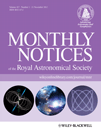Recovering 3D clustering information with angular correlations
ABSTRACT
We study how to recover the full 3D clustering information ofP(k, z), including redshift space distortions (RSD), from 2D tomography using the angular auto- and cross-spectra of different redshift bins Cℓ(z, z′). We focus on quasi-linear scales where the minimum scale λmin or corresponding maximum wavenumber  is targeted to be in the range
is targeted to be in the range  . For spectroscopic surveys, we find that we can recover the full 3D clustering information when the redshift bin width Δz used in the 2D tomography is similar to the targeted minimum scale, i.e.
. For spectroscopic surveys, we find that we can recover the full 3D clustering information when the redshift bin width Δz used in the 2D tomography is similar to the targeted minimum scale, i.e.  which corresponds to
which corresponds to  for z < 1. This value of Δz is optimal in the sense that larger values of Δz lose information, while smaller values violate our minimum-scale requirement. For a narrow-band photometric survey, with photo-z error σz = 0.004, we find almost identical results to the spectroscopic survey because the photo-z error is smaller than the optimal bin width σz < Δz. For a typical broad-band photometric survey with σz = 0.1, we have that σz > Δz and most radial information is intrinsically lost. The remaining information can be recovered from the 2D tomography if we use Δz ≃ 2σz. While 3D and 2D analyses are shown here to be equivalent, the advantage of using angular positions and redshifts is that we do not need a fiducial cosmology to convert to 3D coordinates. This avoids assumptions and marginalization over the fiducial model. In addition, it becomes straightforward to combine RSD, clustering and weak lensing in 2D space.
for z < 1. This value of Δz is optimal in the sense that larger values of Δz lose information, while smaller values violate our minimum-scale requirement. For a narrow-band photometric survey, with photo-z error σz = 0.004, we find almost identical results to the spectroscopic survey because the photo-z error is smaller than the optimal bin width σz < Δz. For a typical broad-band photometric survey with σz = 0.1, we have that σz > Δz and most radial information is intrinsically lost. The remaining information can be recovered from the 2D tomography if we use Δz ≃ 2σz. While 3D and 2D analyses are shown here to be equivalent, the advantage of using angular positions and redshifts is that we do not need a fiducial cosmology to convert to 3D coordinates. This avoids assumptions and marginalization over the fiducial model. In addition, it becomes straightforward to combine RSD, clustering and weak lensing in 2D space.




